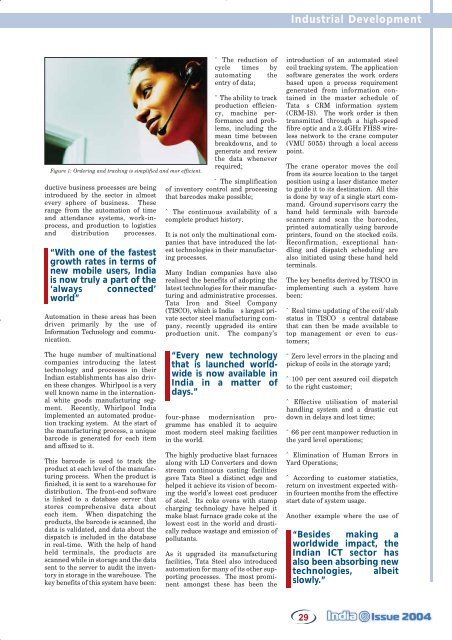Contents - Connect-World
Contents - Connect-World
Contents - Connect-World
You also want an ePaper? Increase the reach of your titles
YUMPU automatically turns print PDFs into web optimized ePapers that Google loves.
Industrial Development<br />
Figure 1: Ordering and tracking is simplified and mor efficient.<br />
ductive business processes are being<br />
introduced by the sector in almost<br />
every sphere of business. These<br />
range from the automation of time<br />
and attendance systems, work-inprocess,<br />
and production to logistics<br />
and distribution processes.<br />
“With one of the fastest<br />
growth rates in terms of<br />
new mobile users, India<br />
is now truly a part of the<br />
‘always connected’<br />
world”<br />
Automation in these areas has been<br />
driven primarily by the use of<br />
Information Technology and communication.<br />
The huge number of multinational<br />
companies introducing the latest<br />
technology and processes in their<br />
Indian establishments has also driven<br />
these changes. Whirlpool is a very<br />
well known name in the international<br />
white goods manufacturing segment.<br />
Recently, Whirlpool India<br />
implemented an automated production<br />
tracking system. At the start of<br />
the manufacturing process, a unique<br />
barcode is generated for each item<br />
and affixed to it.<br />
This barcode is used to track the<br />
product at each level of the manufacturing<br />
process. When the product is<br />
finished, it is sent to a warehouse for<br />
distribution. The front-end software<br />
is linked to a database server that<br />
stores comprehensive data about<br />
each item. When dispatching the<br />
products, the barcode is scanned, the<br />
data is validated, and data about the<br />
dispatch is included in the database<br />
in real-time. With the help of hand<br />
held terminals, the products are<br />
scanned while in storage and the data<br />
sent to the server to audit the inventory<br />
in storage in the warehouse. The<br />
key benefits of this system have been:<br />
ˆ The reduction of<br />
cycle times by<br />
automating the<br />
entry of data;<br />
ˆ The ability to track<br />
production efficiency,<br />
machine performance<br />
and problems,<br />
including the<br />
mean time between<br />
breakdowns, and to<br />
generate and review<br />
the data whenever<br />
required;<br />
ˆ The simplification<br />
of inventory control and processing<br />
that barcodes make possible;<br />
ˆ The continuous availability of a<br />
complete product history.<br />
It is not only the multinational companies<br />
that have introduced the latest<br />
technologies in their manufacturing<br />
processes.<br />
Many Indian companies have also<br />
realised the benefits of adopting the<br />
latest technologies for their manufacturing<br />
and administrative processes.<br />
Tata Iron and Steel Company<br />
(TISCO), which is Indias largest private<br />
sector steel manufacturing company,<br />
recently upgraded its entire<br />
production unit. The company’s<br />
“Every new technology<br />
that is launched worldwide<br />
is now available in<br />
India in a matter of<br />
days.”<br />
four-phase modernisation programme<br />
has enabled it to acquire<br />
most modern steel making facilities<br />
in the world.<br />
The highly productive blast furnaces<br />
along with LD Converters and down<br />
stream continuous casting facilities<br />
gave Tata Steel a distinct edge and<br />
helped it achieve its vision of becoming<br />
the world’s lowest cost producer<br />
of steel. Its coke ovens with stamp<br />
charging technology have helped it<br />
make blast furnace grade coke at the<br />
lowest cost in the world and drastically<br />
reduce wastage and emission of<br />
pollutants.<br />
As it upgraded its manufacturing<br />
facilities, Tata Steel also introduced<br />
automation for many of its other supporting<br />
processes. The most prominent<br />
amongst these has been the<br />
introduction of an automated steel<br />
coil tracking system. The application<br />
software generates the work orders<br />
based upon a process requirement<br />
generated from information contained<br />
in the master schedule of<br />
Tatas CRM information system<br />
(CRM-IS). The work order is then<br />
transmitted through a high-speed<br />
fibre optic and a 2.4GHz FHSS wireless<br />
network to the crane computer<br />
(VMU 5055) through a local access<br />
point.<br />
The crane operator moves the coil<br />
from its source location to the target<br />
position using a laser distance meter<br />
to guide it to its destination. All this<br />
is done by way of a single start command.<br />
Ground supervisors carry the<br />
hand held terminals with barcode<br />
scanners and scan the barcodes,<br />
printed automatically using barcode<br />
printers, found on the stocked coils.<br />
Reconfirmation, exceptional handling<br />
and dispatch scheduling are<br />
also initiated using these hand held<br />
terminals.<br />
The key benefits derived by TISCO in<br />
implementing such a system have<br />
been:<br />
ˆ Real time updating of the coil/slab<br />
status in TISCOs central database<br />
that can then be made available to<br />
top management or even to customers;<br />
ˆ Zero level errors in the placing and<br />
pickup of coils in the storage yard;<br />
ˆ 100 per cent assured coil dispatch<br />
to the right customer;<br />
ˆ Effective utilisation of material<br />
handling system and a drastic cut<br />
down in delays and lost time;<br />
ˆ 66 per cent manpower reduction in<br />
the yard level operations;<br />
ˆ Elimination of Human Errors in<br />
Yard Operations;<br />
ˆ According to customer statistics,<br />
return on investment expected within<br />
fourteen months from the effective<br />
start date of system usage.<br />
Another example where the use of<br />
“Besides making a<br />
worldwide impact, the<br />
Indian ICT sector has<br />
also been absorbing new<br />
technologies, albeit<br />
slowly.”<br />
29
















